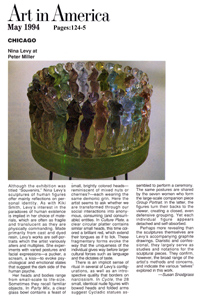SELECTED
PRESS CONTINUED:
PAGE TWO
(IN ROUGHLY
CHRONOLOGICAL ORDER)

| HARRIS, JANE-- ART IN
AMERICA
October 1999 Nina Levy at I-20 Nina Levy's earlier figurative sculpture was concerned with the existential plight of the individual. The faceless multitudes and mixed-sex forms that characterize the compact figural groupings of Bathing Beauties (1994) and Ferris (1995), for example, emphasized anonymity through repetition, and the body as an interchangeable unit. In her recent show, she presented a series of photographs alongside a large-scale sculptural installation. Levy's Cibachrome self-portraits (all 1999), in which certain parts of her anatomy are overlaid with sculptural replacements, engage similar issues as they relate to self-image. Nos. 1, 2 and 3 feature a plaster replica of the artist's head, realistically painted in oil. Though the fake bears a good likeness to the artist, its manic grimace, bulging eyes and larger-than-life scale suggest an uncanny exaggeration of the real. In all the photos, Levy's consistent yet elusive image is centered on a black ground. She seems to emerge from and dissolve back into the void, and the black leotard she wears functions both as clothing and as negative space, fragmenting her body into parts that seem to float and then suddenly coalesce. Levy stages her photos as a relation of parts to whole. In addition to the dialectic of positive and negative space, the disproportionate figures she assembles stress their fabrication through a dynamics of scale and perspective. The cast-iron spine of No. 6, for instance, appears larger than it is because, when photographed, it was positioned two and a half feet in front of the artist's body. Achieving this kind of spatial illusion in a two-dimensional format
may be relatively easy, but another work, Couple, brilliantly
demonstrates a kind of three-dimensional trickery that is truly a feat.
A sculptural installation spread over 20 feet, Couple consists of a
series of nine differently scaled, autonomous body parts made of
plaster, foam, resin and oil, which are attached to steel-rod supports.
The dimensions and arrangement of these parts have been carefully
calibrated with the aid of a camera so that, from the viewer's initial
vantage point, they form a legible tableau. Spatial depth is instantly
foreshortened. One perceives an upright man holding an outstretched,
naked Levy by the waist. As one moves closer the illusion breaks down
like a Hollywood set, and arms, feet, legs, torso and head swim in the
air. Whereas in her photographs Levy reformulates her body to enact a
masquerade of self, in Couple she challenges the self's very integrity. COPYRIGHT 1999 Brant Publications, Inc. |

|
Her heads and bodies range from small-scale to life-size. Sometimes they recall familiar objects. In Party Mix, a clear glass bowl contains a feast of small, brightly colored heads--reminiscent of mixed nuts or cherries?--each wearing the same demonic grin. Here the artist seems to ask whether we are transformed through our social interactions into anonymous, consuming (and consumable) entities. In Culture Plate, a clear circular platter contains similar small heads, this time colored a brilliant red, which extend their tongues as if to lick. These fragmentary forms evoke the way that the uniqueness of the individual gives way before larger cultural forces such as language and the dictates of taste. There is an implicit sense of ritual in several of Levy's configurations, as well as an introspective quality that borders on narcissism. In Cycle, the 28 small, identical nude figures with bowed heads and folded arms suggest Cycladic statues assembled to perform a ceremony. The same postures are shared by the seven women who form the large-scale companion piece Group Portrait In the latter, the figures turn their backs to the viewer, creating a closed, even defensive grouping. Yet each individual figure appears detached and self-absorbed. Perhaps more revealing than the sculptures themselves are Levy's
accompanying graphite drawings. Diaristic and confessional, they
largely serve as studies and notations for the sculptural pieces. They
confirm, however, the broad range of the artist's methods and
concerns, and indicate the various "selves" explored in this
work. COPYRIGHT 1994 Brant Publications, Inc. |